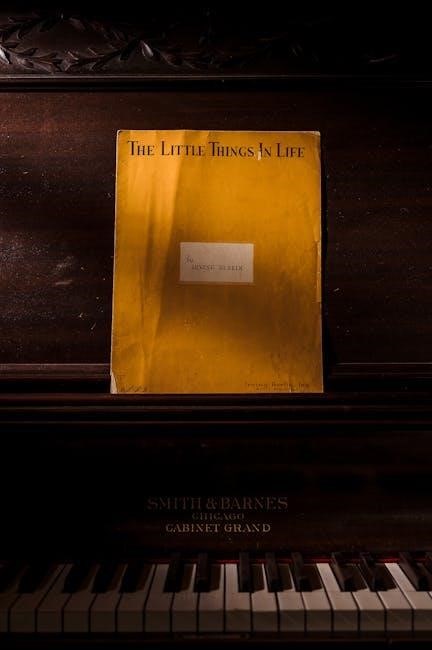piano book for beginners pdf
- Published
- in PDF
Piano Book for Beginners PDF: A Comprehensive Guide
Embark on your musical journey with our comprehensive guide to piano books for beginners in PDF format․ This resource aims to streamline your learning process‚ offering curated information on selecting the right materials and understanding fundamental concepts to get you started․
Welcome to the exciting world of piano! Starting your piano journey as a beginner can feel overwhelming‚ but with the right approach and resources‚ it can be an incredibly rewarding experience․ This section will guide you through the initial steps‚ providing essential information and tips to set you up for success․ Whether you dream of playing classical masterpieces or composing your own songs‚ understanding the basics is crucial․
Piano learning is an effective way to build a strong musical foundation․ The piano combines various methods to keep you engaged‚ like using beginner piano PDF lessons which offer structure and progression․ Finding the right balance between structured learning and enjoyable practice is key․ Many resources are available‚ from free online lessons to comprehensive courses‚ all designed to help you progress from a complete beginner to an intermediate pianist․ Don’t hesitate to explore different methods and find what works best for your learning style․
Remember‚ consistency and dedication are key․ Regular practice‚ even in short bursts‚ is more effective than infrequent long sessions․ Embrace the challenges‚ celebrate your achievements‚ and enjoy the process of discovering the magic of music through the piano․

Choosing the Right Piano or Keyboard
Selecting the right instrument is a crucial first step in your piano learning journey․ The market offers a wide range of options‚ from acoustic pianos to digital keyboards‚ each with its unique features and benefits․ For beginners‚ a digital keyboard is often a practical choice due to its affordability‚ portability‚ and versatility․
When choosing a keyboard‚ consider factors such as the number of keys‚ key action‚ and sound quality․ A full-sized keyboard with 88 keys is ideal for learning proper technique‚ but a smaller keyboard with 61 or 76 keys can be sufficient for beginners‚ especially younger learners․ Key action refers to how the keys feel when you press them․ Weighted keys mimic the feel of an acoustic piano‚ providing a more realistic playing experience and helping to develop finger strength․ Semi-weighted or unweighted keys are lighter and easier to press‚ which can be beneficial for beginners who are still developing their hand strength․

Sound quality is another important consideration․ Look for a keyboard with a variety of instrument sounds‚ including piano‚ organ‚ and strings․ This will allow you to experiment with different sounds and keep your practice sessions engaging․ Many keyboards also come with built-in speakers‚ but you may want to consider purchasing external speakers for better sound quality․
Piano Learning Methods: An Overview
Embarking on your piano learning journey involves choosing a method that aligns with your learning style and goals․ Several approaches cater to beginners‚ each offering distinct advantages․ Traditional lessons‚ often with a private instructor‚ provide personalized guidance and immediate feedback․ This method allows for tailored instruction‚ addressing individual challenges and pacing learning effectively․ However‚ it can be more expensive than other options․
Alternatively‚ self-teaching through books‚ online courses‚ or apps offers flexibility and affordability․ Many excellent piano books for beginners‚ often available in PDF format‚ provide structured lessons and exercises․ Online platforms offer interactive tutorials and video lessons‚ allowing you to learn at your own pace․ Piano learning apps provide gamified exercises and feedback‚ making practice engaging and fun․ When self-teaching‚ it’s crucial to maintain discipline and seek external feedback to ensure proper technique and avoid developing bad habits․
A hybrid approach‚ combining elements of both traditional and self-teaching methods‚ can be particularly effective․ This might involve taking occasional lessons with a teacher to receive personalized guidance while supplementing your learning with books‚ online resources‚ or apps․ Ultimately‚ the best method is the one that keeps you motivated and engaged in your piano studies;
Top Piano Learning Apps for Beginners
In today’s digital age‚ numerous piano learning apps cater specifically to beginners‚ offering interactive lessons and engaging exercises․ Flowkey stands out with its vast library of songs and real-time feedback on your playing․ Simply Piano provides a structured curriculum‚ gamified lessons‚ and personalized exercises to guide you from the basics to more advanced techniques․ Yousician offers a similar approach‚ with a focus on interactive learning and personalized feedback․
For those interested in music theory‚ Teoria offers a comprehensive suite of tools and exercises to learn scales‚ chords‚ and other essential concepts․ Perfect Ear focuses on ear training‚ helping you develop your musical perception and improve your ability to recognize notes‚ intervals‚ and chords․ iReal Pro is a great tool for practicing improvisation and creating backing tracks․
When choosing an app‚ consider your learning style‚ musical goals‚ and budget․ Many apps offer free trials or limited versions‚ allowing you to test them before committing to a subscription․ Look for apps with a structured curriculum‚ real-time feedback‚ and a wide variety of songs and exercises to keep you motivated and engaged․ With the right app‚ you can make significant progress in your piano learning journey․
Piano Basics: Notes‚ Octaves‚ Scales‚ and Tones
Understanding the fundamental elements of music is crucial for any aspiring pianist․ Notes are the building blocks of melodies‚ each representing a specific pitch․ Learning to identify notes on the piano keyboard and in musical notation is the first step towards reading and playing music․ Octaves refer to the interval between two notes with the same name‚ one being twice the frequency of the other․ The piano keyboard is organized into octaves‚ making it easier to navigate and play․
Scales are a sequence of notes arranged in a specific pattern of intervals․ Mastering scales is essential for developing finger dexterity‚ understanding harmony‚ and improvising melodies․ Common scales for beginners include the C major scale and the G major scale․
Tones refer to the quality of sound produced by a musical instrument․ On the piano‚ the tone is influenced by factors such as the force with which the keys are struck and the use of the sustain pedal․ Experimenting with different techniques to produce various tones can add depth and expression to your playing․ Familiarizing yourself with these basics will pave the way for further musical exploration․
Essential Piano Chords for Beginners
Chords form the harmonic foundation of most piano music‚ adding depth and richness to melodies․ For beginners‚ mastering a few essential chords opens a world of musical possibilities․ The C major chord‚ consisting of the notes C‚ E‚ and G‚ is a great starting point․ Similarly‚ the G major chord (G‚ B‚ D) and the F major chord (F‚ A‚ C) are frequently used in simple songs․
Minor chords add a contrasting‚ often melancholic‚ flavor to music․ The A minor chord (A‚ C‚ E) and the D minor chord (D‚ F‚ A) are common minor chords for beginners to learn․ Understanding inversions‚ which involve rearranging the notes of a chord‚ can create smoother transitions between chords and add variety to your playing․
Practice transitioning between these essential chords smoothly and evenly․ Experiment with different rhythms and voicings to develop your own musical style․ Online resources‚ including free PDF chord charts‚ can be valuable tools for learning and memorizing these essential piano chords․ Consistent practice will build muscle memory and enable you to play more complex pieces with confidence․
Playing Your First Piano Melody
Once you’ve grasped the basics of notes‚ chords‚ and hand positioning‚ it’s time to embark on the exciting journey of playing your first piano melody․ Start with simple‚ well-known tunes like “Happy Birthday” or “Mary Had a Little Lamb․” These melodies typically use a limited range of notes and straightforward rhythms‚ making them ideal for beginners;
Focus on accuracy and evenness in your playing․ Pay attention to the rhythm and ensure each note is held for its correct duration․ Use a metronome to develop a steady sense of timing․ Practice slowly at first‚ gradually increasing the tempo as you become more comfortable․ Don’t be discouraged by mistakes; they are a natural part of the learning process․
As you progress‚ try adding simple chords to accompany your melody․ Experiment with different chord voicings and inversions to create a fuller sound․ Online resources and beginner piano books often provide simplified arrangements of popular songs that are perfect for early learners․ With practice and patience‚ you’ll be playing beautiful melodies in no time․
Understanding the Piano Keyboard Layout
Navigating the piano keyboard can seem daunting at first‚ but understanding its layout is essential for any beginner․ The keyboard consists of repeating patterns of white and black keys․ The black keys are arranged in groups of two and three‚ which serve as landmarks for locating specific notes․

Each white key represents a natural note: A‚ B‚ C‚ D‚ E‚ F‚ and G․ These notes repeat across the entire keyboard in that order․ The black keys represent sharps (#) and flats (b) of these natural notes; For example‚ the black key to the right of C is C#‚ and the black key to the left of D is Db (which is the same key as C#)․
Middle C is a crucial reference point․ It’s the C closest to the middle of the keyboard‚ typically located near the nameplate of the piano․ Learning to identify Middle C and the notes around it is a great starting point․ Familiarize yourself with the patterns and relationships between the keys‚ and soon you’ll be navigating the keyboard with ease․
Reading Music: The Musical Staff Explained
Learning to read music is fundamental to playing the piano‚ and the musical staff is where it all begins; The staff consists of five horizontal lines and four spaces‚ each representing a different musical pitch․ Notes are placed on these lines and spaces to indicate which notes to play․
The staff is divided into two main sections: the treble clef (used for higher notes‚ typically played by the right hand) and the bass clef (used for lower notes‚ typically played by the left hand)․ The treble clef is also known as the G clef because it curls around the G line on the staff․ The bass clef‚ also known as the F clef‚ has a dot on either side of the F line․
To determine which note each line and space represents‚ you need to memorize the order of the notes on both clefs․ A helpful mnemonic for the treble clef lines is “Every Good Boy Does Fine” (E-G-B-D-F)‚ and for the spaces‚ it’s “FACE” (F-A-C-E)․ The bass clef lines are “Good Boys Do Fine Always” (G-B-D-F-A)‚ and the spaces are “All Cows Eat Grass” (A-C-E-G)․
Free Piano Lessons and Sheet Music Resources (PDF)
The internet offers a plethora of free resources for aspiring pianists․ Many websites provide free piano lessons for beginners in PDF format‚ covering topics such as basic music theory‚ finger exercises‚ and simple songs․ These lessons often include diagrams and illustrations to aid understanding․
In addition to lessons‚ numerous websites offer free sheet music in PDF format․ This allows beginners to practice playing familiar melodies without incurring any costs․ Look for simplified arrangements of popular songs‚ as these are easier to learn and provide a sense of accomplishment․
Many of these resources are designed to be printed out‚ making them convenient for practicing at the piano․ Some websites also offer interactive lessons and tutorials‚ which can be a great way to supplement your learning․
Remember to explore various websites and resources to find the ones that best suit your learning style․ With so many free options available‚ you can start your piano journey without spending any money on lessons or sheet music․
Recommended Piano Books and Courses for Beginners
Choosing the right learning materials is crucial for a successful start to your piano journey․ Several excellent piano books are specifically designed for beginners․ “Alfred’s Basic Piano Library” and “John Thompson’s Modern Course for the Piano” are classics‚ offering a structured approach to learning fundamental skills․

These books typically cover topics such as note reading‚ rhythm‚ basic chords‚ and simple melodies․ They often include exercises and songs to reinforce learning․
In addition to books‚ consider exploring online piano courses․ Platforms like Skoove and Flowkey offer interactive lessons and personalized feedback‚ making learning more engaging and effective․ Many courses also provide access to a library of sheet music and backing tracks․
For those interested in a more comprehensive approach‚ “Learn & Master Piano” is a highly regarded course that covers a wide range of topics‚ from basic technique to advanced improvisation․ It includes instructional videos‚ a lesson book‚ and access to an online community․
Ultimately‚ the best piano book or course depends on your individual learning style and goals․ Experiment with different resources to find the one that resonates with you and keeps you motivated․
